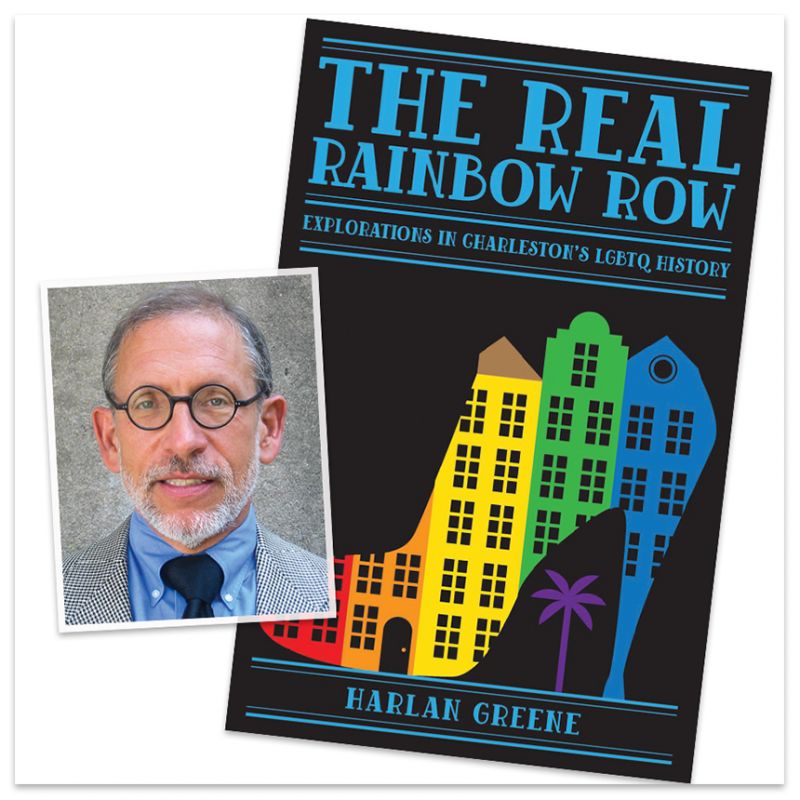The Real Rainbow Row is out this month

In the exisiting canon of Charleston history, LGBTQ people have been largely nonexistent. They have been relegated to the shadows and remained in the silences. Not anymore; (Inset) Author, Harlan Greene.
“To give an accurate description of what has never occurred is not merely the proper occupation of the historian, but the inalienable privilege of any man of parts and culture,” quipped the immensely quotable Oscar Wilde. The Irish poet and playwright, who visited Charleston in 1882 and set the city atwitter with his unfettered flamboyance, shows up in Harlan Greene’s The Real Rainbow Row (Evening Post Books, October 2022), as do any number of notable LGBTQ people who left their mark on the Holy City.
As an accomplished author of award-winning novels and nonfiction, a College of Charleston archivist, and history editor for Charleston magazine, Greene (along with Nic Butler of the Charleston County Public Library) is the go-to for “accurate descriptions” of what has indeed occurred in Charleston’s 350-plus years. I include Wilde’s wisecrack not to suggest that historians like Greene are writing fiction but because the punch line does hold truth: historians, as much by virtue of what they choose not to describe as what they do, exert power and privilege. They actively shape history as they tell it—the silences, the negative space in the picture they create, can be as revealing as what is told. This is the whole point of Greene’s comprehensive, insightful new book. In the existing canon of Charleston history, LGBTQ people have been largely nonexistent. They have been relegated to the shadows and remained in the silences. Not anymore.
In The Real Rainbow Row, Greene takes us on a chronological tour through the Holy City, with a lens toward illuminating that gay, transgender, and nonbinary people, as well as gender fluidity, have been as ever-present and formative as the oyster beds that shape this land the first settlers called Oyster Point. Like long buried secrets, a run-in with oysters obscured by high tides and pluff mud can cause painful, dangerous wounds. By digging through that pluff mud to uncover what has been hidden, Greene not only makes it safer for those traveling this terrain, but also he removes crusty layers of cultural shame to reveal true pearls—people whose contributions to this community have been important and enduring, but whose full humanity has never been included in the story.
Greene’s prose moves at a healthy pace, taking us through the earliest days of the Lowcountry’s indigenous people, the colonial era, the Revolution, the Civil War, the civil rights era, and on to the present day, with each chapter introducing fascinating figures. Some are well known, like Alexander Hamilton (who had a “romantic friendship” with South Carolina patriot John Laurens) and others less so, like Ada Agnes Jane McElhenney, aka the “Queen of Bohemia,” a bisexual woman, who in need of money to move away, stole funds from the Ladies Calhoun Memorial Association in 1834, delaying the monument’s erection for years.
I often wonder what it must be like to walk around Charleston with the depth of knowledge that someone like Greene possesses. I imagine he must hear whispers and echoes as he passes by the home of transgender writer Dawn Langley Simmons or the corner of College and Green streets, where from 1946 to 1971 the Book Basement became an intellectual hub and welcoming haven for LGBTQ people, as well as those of all races and backgrounds. Maybe he taps his toes to distant music rising from the long-gone East Cooper juke joints where Shake-a-Plenty delighted Gullah audiences with lively drag shows. Such richness. So many heart-lifting and heartbreaking layers in the sediment of our collective story.
Thankfully we now have a fuller story, one that includes those who dared to embrace their whole selves and those they loved, regardless of how taboo or dangerous it was to do so.
As the openly gay writer James Baldwin once said, “People are trapped in history, and history is trapped in them.” In The Real Rainbow Row, Greene opens the doors. There can be no rainbow without sunlight, and Greene lets that light shine in.